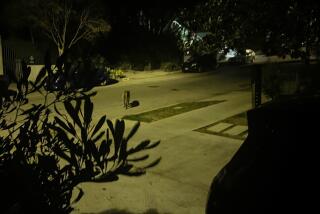A Trapper on the Trail of Problem Coyotes
- Share via
Robert Garnica has been going where coyotes go for 15 years as a full-time trapper for the Los Angeles County agriculture commissioner’s pest management division. He drives overgrown paths and walks concrete storm ditches near hillside homes where backyards beckon with fruit trees, dog-food dishes, cats and children.
“I cannot advertise what I do,” Garnica said during a recent dawn patrol in Diamond Bar. “People are against what we do. What can I say? We’re trying to protect people and their pets.”
Outwitting coyotes takes years of practice. The wily animals quickly learn to avoid cages or even carefully camouflaged traps that give off a human scent.
When he does trap one, Garnica, 49, dispatches the animal with a single shot from a .22-caliber rifle. Garnica’s boss, Raymond Smith, says shooting is usually the most humane way to dispose of problem coyotes. The law prohibits release of such animals into the wild and a relocated coyote would probably be killed by other coyotes in the area anyway.
Sometimes Garnica goes months without trapping an animal before his luck changes. Then he might catch seven in a single week, as he did in Diamond Bar recently. He confines his work mainly to public land, venturing onto private property only when invited by owners concerned that coyotes are coming too close, too often. When a coyote begins showing no fear of people, it can be a prelude to an attack.
With the multiplicity of jurisdictions involved and no central accounting of incidents involving coyotes, the scope of the problem of people being bitten and attacks on pets in the Southland is uncertain.
Just recently, two young children -- one in Northridge and another in Glendale -- were severely mauled.
Wheeling his vehicle over a tall curb and toward one of his traps in Diamond Bar, Garnica leaned forward and pointed to a concrete ditch running up a developed bluff.
“He’s probably coming right through here,” Garnica said. The loss of several pet cats in the neighborhood had prompted his visits here.
Scat and paw prints indicate that this is a well-used coyote corridor. Yet Garnica’s trap is empty and the bait undisturbed. Chances are, he said, the coyote recognized his handiwork or his scent.
If he can trap just one coyote, Garnica hopes, others in the area may sense peril and depart.
Garnica reset the trap with a different kind of bait. Then he opened a vial of deer urine he carries for just such occasions and spread it nearby, hoping to disguise his own scent.
Garnica uses spring-loaded snares specially designed to catch coyotes.
A cable loop as wide as a grocery bag is buried an inch beneath loose soil. The bait, typically a mound of glycerin and dog food, lies on a steel plunger that trips the spring when a coyote applies enough force to the bait.
When triggered, the looped cable encircles the coyote’s head. By struggling, the animal closes the loop around its neck. A rubber stopper on the cord is meant to prevent suffocation.
Garnica said he has never caught a household pet in one of his traps, which he checks every day.
Garnica operates mostly in the San Gabriel Valley, although he avoids cities that do not have a formal arrangement with the county.
Residents of those cities must rely on private pest-control firms.
Los Angeles County trappers caught and killed 51 coyotes in 2002, but in previous years they have caught 100 or more.
Smith said his trappers last year snared coyotes across a wide swath of the county, from Rolling Hills to Glendale in the San Fernando Valley and from West Covina to Hacienda Heights and Diamond Bar in the San Gabriel Valley.
County officials believe some illegal private efforts continue around the county to trap, shoot or poison coyotes.
In 1998, National Park Service biologists working near the Santa Monica Mountains found half a dozen coyotes poisoned with a rodenticide. Poisoning wildlife is illegal in California.
Smith estimates there are “thousands, maybe tens of thousands” of coyotes in Los Angeles County.
He believes that in places where lush suburban backyards sit next to chaparral-filled canyons, there may be enough food and hiding places to support up to 10 times the area’s normal population of coyotes. Catching coyotes is only a part of Garnica’s job. Keeping them away from pets and children begins not with trapping, he said, but with educating the public about avoiding the animals.
Any food or water left outside is an invitation, as is garbage left unsecured, Garnica said. Backyard fruit trees are also a temptation. Gardens and lawns attract rabbits, which, in turn, lure coyotes. An outdoor rabbit hutch is a gift-wrapped enticement. And even tall fences have proven vulnerable to determined coyotes, which are agile climbers and diggers.
Garnica often must explain to anguished homeowners who have lost pets that they will probably have to learn to live with coyotes, even if he is able to trap an offending animal or two.
Despite decades of efforts to wipe them out across much of the Western U.S., coyotes have proven to be among the most resilient of all wildlife.
With many people, Garnica must justify his job. He tells them he has pets and keeps chickens and takes no pleasure in killing coyotes.
“You’re damned if you do and damned if you don’t,” he said. “Somebody’s got to go in there and take out an animal.”
More to Read
Sign up for Essential California
The most important California stories and recommendations in your inbox every morning.
You may occasionally receive promotional content from the Los Angeles Times.













